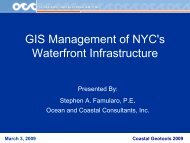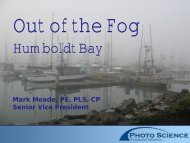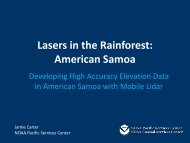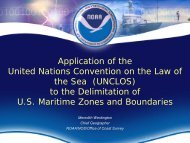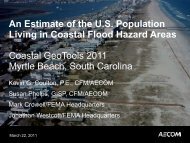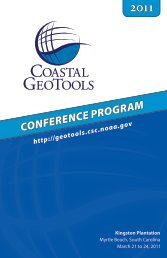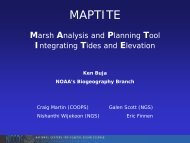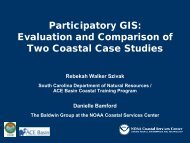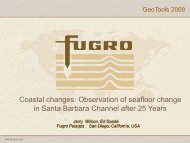Lynne Dingerson, The Baldwin Group at NOAA Coastal ... - GeoTools
Lynne Dingerson, The Baldwin Group at NOAA Coastal ... - GeoTools
Lynne Dingerson, The Baldwin Group at NOAA Coastal ... - GeoTools
You also want an ePaper? Increase the reach of your titles
YUMPU automatically turns print PDFs into web optimized ePapers that Google loves.
<strong>Coastal</strong> Applic<strong>at</strong>ions of High<br />
Resolution Elev<strong>at</strong>ion D<strong>at</strong>a<br />
Rebecca M<strong>at</strong>aosky<br />
<strong>NOAA</strong> <strong>Coastal</strong> Services Center
Purpose<br />
To highlight some of the common coastal<br />
applic<strong>at</strong>ions of high resolution elev<strong>at</strong>ion d<strong>at</strong>a<br />
<strong>Coastal</strong> Applic<strong>at</strong>ions<br />
• <strong>Coastal</strong> inund<strong>at</strong>ion prediction<br />
• Lake level drop impacts<br />
• <strong>Coastal</strong> change visualiz<strong>at</strong>ion<br />
• Shoreline deline<strong>at</strong>ion<br />
• Habit<strong>at</strong> mapping
High Resolution Elev<strong>at</strong>ion D<strong>at</strong>a:<br />
How to Define<br />
For this present<strong>at</strong>ion, high resolution elev<strong>at</strong>ion d<strong>at</strong>a:<br />
• Provide elev<strong>at</strong>ions of Earth’s surface on land or under w<strong>at</strong>er<br />
• Support a grid cell resolution of five meters (m) or less<br />
• Meet a vertical accuracy of one meter or less RMSE<br />
(root mean square error)<br />
• Meet a horizontal accuracy of five meters or less RMSE<br />
• Are d<strong>at</strong>a th<strong>at</strong> can be collected by aerial or b<strong>at</strong>hymetric surveys
Types of High Resolution Elev<strong>at</strong>ion D<strong>at</strong>a<br />
Topographic B<strong>at</strong>hymetric Topob<strong>at</strong>hy<br />
Land elev<strong>at</strong>ion Seafloor elev<strong>at</strong>ion Combines topographic and<br />
b<strong>at</strong>hymetric d<strong>at</strong>a to cre<strong>at</strong>e<br />
a seamless model of the<br />
interface between<br />
land and w<strong>at</strong>er
<strong>Coastal</strong> Inund<strong>at</strong>ion Prediction<br />
<strong>The</strong> condition under which w<strong>at</strong>er covers normally dry land<br />
• Caused by storm surges, tsunamis, inland flooding, high tides, sea level rise<br />
• Can result in severe onshore impacts<br />
• Predicting the extent of the inund<strong>at</strong>ion can aid in decision making<br />
<strong>The</strong> SLOSH (Sea, Lake, and Overland<br />
Surges from Hurricanes) model and<br />
other inund<strong>at</strong>ion prediction models use<br />
topob<strong>at</strong>hy d<strong>at</strong>a as a base of analysis.
<strong>Coastal</strong> Inund<strong>at</strong>ion Prediction<br />
<strong>The</strong> SLOSH results can then be mapped onto a high resolution<br />
topographic surface (lidar) to cre<strong>at</strong>e an inund<strong>at</strong>ion map th<strong>at</strong> shows<br />
which areas are likely to be inund<strong>at</strong>ed by each storm c<strong>at</strong>egory.<br />
Storm surge zones by<br />
hurricane c<strong>at</strong>egory for<br />
Ch<strong>at</strong>ham County, Georgia
<strong>Coastal</strong> Inund<strong>at</strong>ion Prediction<br />
SLOSH Run C<strong>at</strong>egory 1 Maximum of Maximums<br />
SLOSH Elev<strong>at</strong>ion on N<strong>at</strong>ional Elev<strong>at</strong>ion D<strong>at</strong>aset<br />
SLOSH Elev<strong>at</strong>ion on lidar
<strong>Coastal</strong> Inund<strong>at</strong>ion Prediction<br />
Mean sea level (MSL)<br />
Mean high w<strong>at</strong>er<br />
(MHW)<br />
MHW + 0.6 m (IPCC*)<br />
MHW + 0.8 m (IPCC)<br />
Hurricane Hugo<br />
Hugo + 0.8 m<br />
* IPCC – Intergovernmental Panel on Clim<strong>at</strong>e Change
<strong>Coastal</strong> Inund<strong>at</strong>ion Prediction<br />
Shallow <strong>Coastal</strong> Flooding<br />
High tides in Charleston, South Carolina, often cause shallow<br />
coastal flooding, which is defined by the N<strong>at</strong>ional We<strong>at</strong>her<br />
Service as a tide of 7.0 feet or more.
<strong>Coastal</strong> Inund<strong>at</strong>ion Prediction<br />
Shallow <strong>Coastal</strong> Flooding<br />
Shallow coastal flooding inund<strong>at</strong>ion and sea level rise map
Lake Level Drop Impacts<br />
Lake Ontario<br />
<strong>The</strong> N<strong>at</strong>ure Conservancy is examining the impacts of lake level<br />
drop on coastal habit<strong>at</strong> migr<strong>at</strong>ion and developing effective<br />
conserv<strong>at</strong>ion and management str<strong>at</strong>egies.
Lake Level Drop Impacts<br />
Topob<strong>at</strong>hy Surface of Lake Ontario<br />
Cre<strong>at</strong>ed from<br />
gridded <strong>NOAA</strong><br />
hydrographic survey<br />
d<strong>at</strong>a combined with<br />
U.S. Geological<br />
Survey topographic<br />
grids, ~90 m<br />
resolution
Lake Level Drop Impacts<br />
Developing an inventory of available topo and b<strong>at</strong>hy d<strong>at</strong>a<br />
sources to produce topob<strong>at</strong>hy surfaces for areas of interest
Lake Level Drop Impacts<br />
From this USACE topob<strong>at</strong>hy lidar, new site-specific<br />
topob<strong>at</strong>hy surfaces will be constructed for TNC’s areas of interest
<strong>Coastal</strong> Change Visualiz<strong>at</strong>ion<br />
Monitoring shoreline change allows coastal resource managers to keep the<br />
public informed, invest time and effort in <strong>at</strong> risk areas, prioritize habit<strong>at</strong><br />
restor<strong>at</strong>ion, and model the success of potential protective measures.<br />
Pre-nourishment<br />
Post -nourishment
<strong>Coastal</strong> Change Visualiz<strong>at</strong>ion<br />
1997<br />
2000<br />
2007<br />
Isle of Palms – Wild Dunes
<strong>Coastal</strong> Change Visualiz<strong>at</strong>ion<br />
High resolution topob<strong>at</strong>hy d<strong>at</strong>a collected <strong>at</strong> different times<br />
allows for assessment of coastal change in beach<br />
volume and extent.
<strong>Coastal</strong> Change Visualiz<strong>at</strong>ion<br />
1997<br />
2000<br />
2007<br />
Folly Beach
Shoreline Deline<strong>at</strong>ion<br />
A topob<strong>at</strong>hy surface allows for a legally defensible,<br />
reproducible shoreline and reduces subjectivity
Shoreline Deline<strong>at</strong>ion<br />
<strong>NOAA</strong> is experimenting with using a topob<strong>at</strong>hy surface cre<strong>at</strong>ed<br />
from lidar elev<strong>at</strong>ion d<strong>at</strong>a sets to deline<strong>at</strong>e shoreline<br />
Advantages<br />
• Provides a defined, measurable accuracy<br />
• Provides ancillary d<strong>at</strong>a on shoreline aspects,<br />
slopes, and morphology<br />
• Can be cre<strong>at</strong>ed economically under wider range<br />
of tidal stages<br />
Shoreline derived from a topob<strong>at</strong>hy surface near San Francisco, CA, 2008
Shoreline Deline<strong>at</strong>ion<br />
Setback Lines<br />
South Carolina has<br />
used a topob<strong>at</strong>hy<br />
surface to determine<br />
the crest of the<br />
primary dune.
Shoreline Deline<strong>at</strong>ion<br />
Something to Consider<br />
Using different methods to cre<strong>at</strong>e the topob<strong>at</strong>hy<br />
surface can introduce some bias and uncertainty.
Habit<strong>at</strong> Mapping<br />
High resolution elev<strong>at</strong>ion d<strong>at</strong>a, such as lidar, can produce a high level of<br />
detail for analyzing how n<strong>at</strong>ural and manmade thre<strong>at</strong>s such as sea level<br />
rise, drought, storm flooding, and development may affect a wetland.<br />
China Camp<br />
Typical marsh elev<strong>at</strong>ion p<strong>at</strong>tern<br />
Stege Marsh<br />
Atypical marsh elev<strong>at</strong>ion p<strong>at</strong>tern<br />
Ustin, 2007
Conclusion<br />
High resolution elev<strong>at</strong>ion d<strong>at</strong>a<br />
• Provides a solid base for coastal analysis<br />
• Provides valuable inform<strong>at</strong>ion and visualiz<strong>at</strong>ion capability<br />
to researchers and coastal managers<br />
• Can be used to predict inund<strong>at</strong>ion extents, visualize<br />
coastal change, establish a repe<strong>at</strong>able shoreline, and map<br />
habit<strong>at</strong>s
For More Inform<strong>at</strong>ion<br />
A Roadmap to a Seamless Topob<strong>at</strong>hy Surface<br />
A series of products to help users cre<strong>at</strong>e seamless coastal maps<br />
Includes:<br />
• D<strong>at</strong>a inventory<br />
• Topographic and B<strong>at</strong>hymetric<br />
D<strong>at</strong>a Consider<strong>at</strong>ions<br />
• Examples of coastal applic<strong>at</strong>ions<br />
www.csc.noaa.gov/topob<strong>at</strong>hy
Contact Inform<strong>at</strong>ion<br />
Lindy Betzhold or Rebecca M<strong>at</strong>aosky<br />
<strong>Lynne</strong>.Betzhold@noaa.gov<br />
Rebecca.M<strong>at</strong>aosky@noaa.gov



